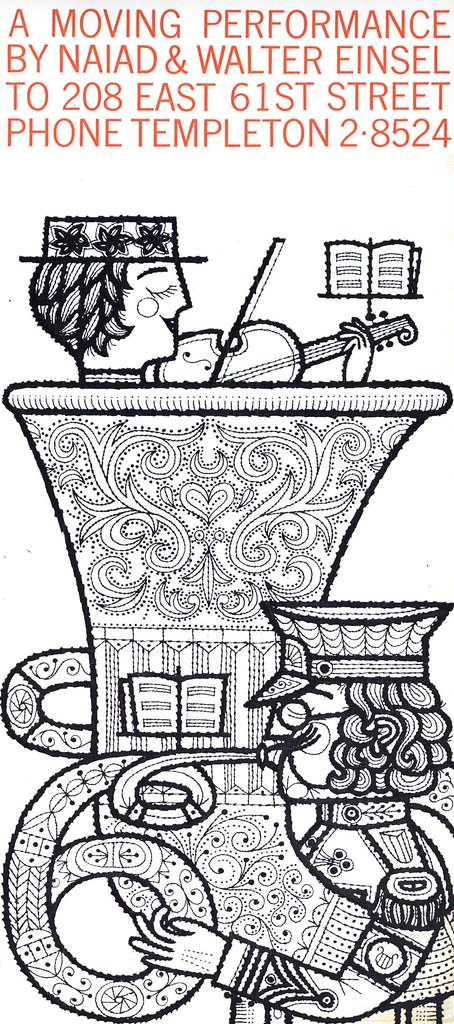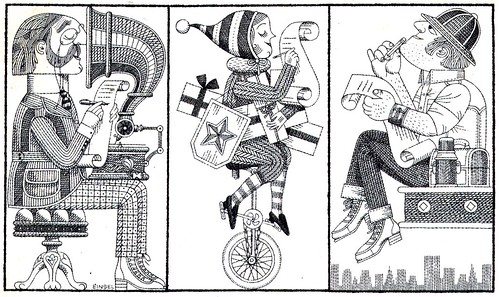
The Einsels employed a method of working Naiad calls "leapfrogging".
"This is especially useful when one or both of us is under pressure of a heavy work load. First we'd sit down and verbally consult, brainstorming ideas. Then I'd draw a little sketch and Walter would add to that and we'd go on and on in this way, refining all the time."The Einsels would sign the finished piece according to who received the assignment.
The 50's were a busy time for the young couple. As well as illustration work, they were starting a family with daughters, Leslie, born in 1956 and Hilary, in '58. During one lucrative assignment from Collier's magazine Naiad recalls, "I just rocked that carriage with one hand and drew a five-page spread with the other."

As well, a big move was coming for the Einsels: by the mid-60's they had traded in their one room New York City apartment for a circa 1853 Victorian farmhouse in Westport Connecticut. West port had long been home to some of America's most famous illustrators, including many of those whose work the teenage Naiad had admired in Seventeen magazine.

"We met some of the realistic illustrators at the Society of Illustrators & a few of them in Westport where they are revered. They were quite a bit older than we were. A lot of them taught at Famous Artists school here in town. We were friendly with Bernie Fuchs, Fred Otnes, Howard Munce, Wendall Minor, Jerry Pinkney, MurrayTinkleman & others closer to our age."
Of those realistic artists she adds, "As a member of the Society of Illustrators I was kept aware of their work & did actually meet many of them & still admired their work but they no longer influenced me."
That bottom piece by Einsel really reminds me of the work of John Vernon Lord (no bad thing).
ReplyDeleteAnd thanks for the fabulous blog as a whole, by the way. Great stuff.
Facinating read, Leif. Thanks so much for seeking Naiad out and posting her story.
ReplyDeleteThanks for your comments, guys! I have been forwarding them to Naiad and she is just thrilled to know her and Walter's work ( and their story ) is being so well received. :-)
ReplyDeleteThanks again, Leif. That top illustration reminds me of Melinda Beck.
ReplyDeleteLeif, this is brilliant and so enjoyable. Thank you, and thank you Naiad as well for sharing so much. As a community of artists, and especially for young students and recent grads (almost all of whom aren't being taught anything about the recent history of our field), it helps us in so many ways to have you share your life's story with us.
ReplyDeleteI'm especially intrigued at hearing from Naiad how much the freelance jobs were paying at the time. It certainly makes more sense to hear that spots averaged $15 each, than what I have heard some older illustrators say (somewhere on the IPA's site http://www.illustratorspartnership.org/ if memory serves), that in the 1950s, artists could make upwards of $1000 or more for a magazine cover. That always sounded rather absurd -- not to say it might not have happened to a lucky few. But that amount today would be a downpayment on a house!
Lief: we all benefit so much from your dedication to Today's Inspiration as well, seriously. I'm always so impressed that you are still at it, since the early days when you began your TI emails (6 years ago?), and now to this very resourceful blog and your Flickr account. Every day. It's amazing. You're becoming the historian we never knew we needed.
*blush* Thanks guys! :-)
ReplyDelete